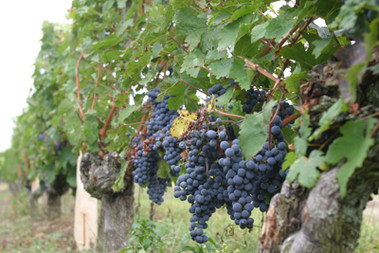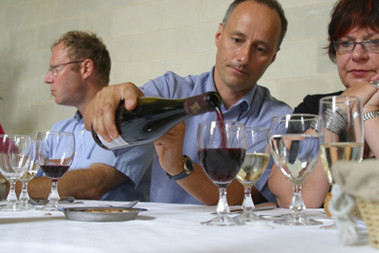Losing Ground: French winemakers struggle with global competition
October 1, 2006 - The Star Ledger - Op-Ed

SAUMUR, France—As the wine harvest kicks into full swing in France, big gears are slowly beginning to turn in an industry thrown into crisis mode, reflecting a very French ability to simultaneously seduce and infuriate themselves and the rest of the world.
For hundreds of years, France was the world’s indisputable reference for wine quality. Different regions across the country eventually took the wise step of name-protecting their wines in what’s called an AOC—short form for Appellation d’Origine Contrôlée—which both gave them a marketing edge and became something of a Good Housekeeping Seal for the customer.
Now, however, something’s gotta give. Many other countries are now making fantastic wines that easily compete on the world market in terms of quality and volume, and at home, wine is losing ground to beer and other drinks. Winemakers here have been quick to point out the problems, but have done little to react.
The French wine classification system is the first place to look for what’s gone wrong.
The AOCs should be a guarantee of quality—a unique expression of the winemaker, the grapes they use, the soil, their skills in the field, the aging process and their abilities as winemakers (all of this is wrapped into the vague but romantic notion of what’s called terroir).
When it works, AOC or not, you get that unique expression and something far less homogenous than the generic junk from around the world that often occupies much of the real estate on American liquor store shelves.
However, the French wine classification system has evolved into a ridiculous 11-level liquid pyramid that starts out with table wines at the bottom and AOCs at the top; in theory, the volume of the wine produced would go down and the quality would go up as you worked your way to the top, but the AOCs alone now account for more than 50 percent of wine production and can represent both the best and worst of wine.
 Claude Guichet, export director for Alliance Loire, pours a glass of Touraine for his neighbor. “These winemakers want to be around in 10 or 20 years,” he says. “People who don’t adapt won’t make it.” PHOTO BY JOE RAY
Claude Guichet, export director for Alliance Loire, pours a glass of Touraine for his neighbor. “These winemakers want to be around in 10 or 20 years,” he says. “People who don’t adapt won’t make it.” PHOTO BY JOE RAYWith the 11 levels and hundreds of individual AOCs, even the best wine snobs have trouble figuring out which end is up. Confronted with the choice between an Australian Shiraz a consumer hasn’t tried and an obscure AOC like Pécharmant (which really does exist), what’s a hurried American shopper going to choose?
Though some producers persist with the idea of having the wine from their lost corner of the country turned into an AOC, the most common idea circulating through the French wine community is simplification.
Imagine how much easier choosing a wine would be if you walked into the wine shop and the label said something you could interpret as “good,” ‘better” or “best.”
Another great idea would be to consistently use some of the space on the back of the bottle to give the client some idea of what the wine will taste like and what it goes well with. Cheaper wines could even get away with little pictograms. Why not?
Ideas like these are particularly important for the export market. Most AOCs are blends of different kinds of grapes. Most Champagne, for instance, is a blend of Pinot Noir, Pinot Meu nier and Chardonnay grapes, with a couple of others thrown in for good measure. Outside of Europe, however, most wines are what are known as monovarietals made up of only one kind of grape. Syrahs are made by producers around the world, and there’s plenty of variety within that group. Burgundies, however, can only come from Burgundy.
In the Loire Valley, producers got tired of waiting for a higher power—God, government, or otherwise—to tell them what to do or help them out of their jam.
“The problem is not that we talk or think a lot (about the problems), but we don’t act too well,” says Claude Guichet, referring to winemakers, but seemingly giving a course in basic French psychology. As the export director for Alliance Loire, a group of nine Loire Valley cooperative producers which represent some 800 winemakers, Guichet understands the importance of small producers working together in order to survive in the long run.
“These winemakers want to be around in 10 or 20 years,” he says. “People who don’t adapt won’t make it.”
Alliance Loire’s efforts are easiest to see with entry-level wines called “Vallée Loire”—a sort of umbrella label for regional wines made by Alliance Loire’s group of producers.
“We’re trying to keep the client from getting lost,” says Elo die Rume, who coordinates Alliance Loire’s marketing efforts, as Guichet shows me a photo of five styles of regional wine, all under an additional black and white label that simply says “Vallée Loire.” It’s an idea that allows for variety, yet also helps different products to stick out on a supermarket shelf. A customer might not know AOCs like a Bourgueil or Saumur, but they’ll probably be able to recognize the Loire Valley’s name above it all.
Alliance Loire, now four years old, is also setting up similar structures for both higher and lower quality wines and, for very basic wines, even toying with heretical-in-France ideas like screw- top caps, boxed wines and even Tetra-Pak presentations. With Florida’s ABC Fine Wine & Spirits chain of liquor stores, they’ve even succeeded in cutting out the middlemen.
There are scads of other good ideas out there. Here are a couple: on the domestic front, large winemaking groups could start helping French cafés and bars stock better-quality wine (which is mysteriously and near-ubiquitously mediocre), or even open up their own establishments, like many beer makers are doing. For those looking to push their exports, they could seek more marketing advice from the country where they’re selling their wines or simply hand that end of things over to the country in which they’re trying to sell. AOC restrictions could also be loosened so that producers can also sell the wine from their Merlot grapes as a monovarietal on the world market.
Alliance Loire is making an applaudable effort that will cer tainly save the careers of scores of winemakers who simply lack the marketing savvy to succeed in a troubled market, and it is certainly ahead of the game compared with many similar regions across the country, but there are still a few red flags.
At one point during an informal Q&A session, an Alliance Loire representative simply talked louder than the questioner with a dissenting viewpoint, while the director of a local co-operative took a sudden interest in the state of his cuticles.
Very simply, they don’t have all the answers, but the chances they are taking are innovative and praise-worthy, and they are paying off. Other winemakers and winemaking groups would do well to use them as a model or as inspiration to take up their own initiatives.
Alliance Loire’s efforts are paying off, allowing them to export what Guichet estimates to be around 15,000 cases per year—a number he’s predicting to rise to 40,000 five years from now.
“We’ve had success every year since we’ve started,” concludes a grinning Guichet. “Every year it goes up.”
Joe Ray, a food and wine specialist, is based in Paris. He may be reached via his Web site, www.joe-ray.com.
This story also appeared with: The Seattle Times